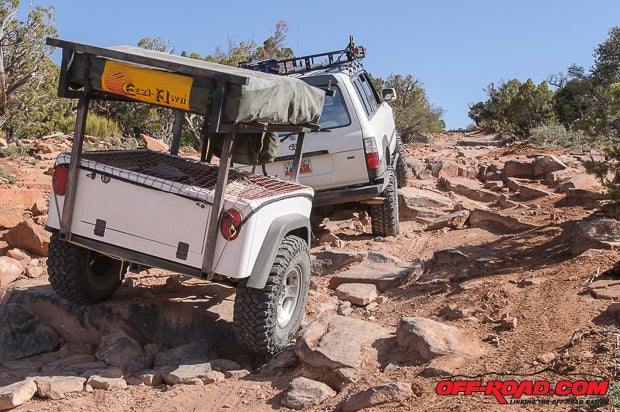
The history of 4x4s is long-standing string of short wheelbase, compact vehicles that have sought maneuverability, even at the cost of cargo space. Everything from the Bantam, Willys and CJ Jeeps, to the FJ40 and Bronco has been high on capability and low on storage space. Essentially the maneuverability has come at a cost. This balancing act of cargo/passengers versus trail prowess has been influencing vehicles choices by off-road enthusiasts for decades. Think Defender 90 vs. Defender 110, or TJ vs. JK Rubicon.
But life happens. Kids are soon being loaded in car seats below roll bars. Tents start to feel claustrophobic. Hauling a folding table makes sense, as does a larger cooler. And so the pattern goes. Before you know it, your vehicle has become too small for the people and gear you’re loading. What to do then, especially when you’ve built the rig of your dreams?
Fortunately, there are as many solutions for hauling mountains of gear as there are vehicle options. But, also like vehicles, there are really only a handful of types of solutions. Roof racks, so-called jamboree racks, swing-away bumpers systems, and hitch carriers all expand capacity. Yet none of these solutions tend to add more than a few dozen cubic feet of storage. In the end, most off-roaders realize that the only significant solution for hauling additional gear is a trailer.
Trailers have offered cargo solutions since soldiers pulled Bantams behind their like-named Jeeps. Today, the game changer that trailers offer to 4x4 enthusiasts is being widely acknowledged. The trend, which arguably began with Aussies in need to greater capacity as they explored the Outback, has spread. Who offered the first off-road trailer? It’s hard to say, though I tried one of the earliest—the VenturCraft Trailblazer—in the U.S. back at the turn of the century. Today, consumers have a variety of choices. The marketplace is full of trailers in numerous shapes, sizes and levels of complexity.
Unfortunately for those of us on a budget, the marketplace has shifted toward high-end consumers. These Aussie-inspried bumpers often sport aluminum and stainless-steel construction, along with a host of gadgets and pop-out options. Off-road trailers, which are basically synonymous with off-road tent trailers (as most are equipped with them), can cost as much as the tow rig at times, ranging from $5,000 up to $20,000 for versions from Adrenalin, Kimberly and others. While off-road trailers have become more complex and durable, they have also become more costly.
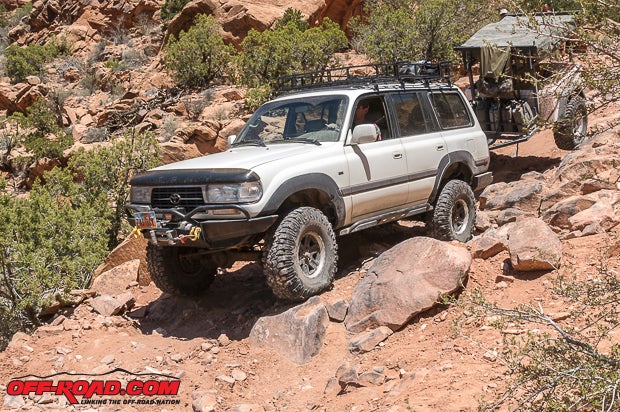
Staying Grounded
If you’re not looking to take out a loan to get the added flexibility a trail-worthy trailer offers, you’re not alone. For most buyers, a trailer should add options without breaking the bank. As a result, the assumption has been that customizing a surplus military trailer or something similar is the only option other than breaking the bank. That was the dilemma that spurred one designer to ask ‘why not make a new option?’
Scott Chaney, president and owner of Compact Camping Concepts (CCC; http://www.compactcampingconcepts.com/), is a designer and problem solver at heart. He’s also a consummate backcountry explorer. In 2006 he embarked, somewhat by accident, on a journey into off-road and adventure trailers. Unable to find a lightweight trailer that fit his exploring goals, he built his own. The combination of positive response and getting a membership to the “cast-off employee society” from a large electronics firm led to launching CCC. The response was so positive that he launched his small Oregon company and began producing one innovative trailer after another. What sets his models apart is a core commitment to lightweight design, customizability, and the notion that owners can be builders. The elegant solutions that resulted can be seen in models such as the Explorer Box and Utilitarian. From micro versions that motorcycles can tow to Rubicon-ready designs, trailer specifications can be adjusted to meet your needs with one of their varied models.
As a designer by training, the out-of-the-box nature of Scott’s designs caught my eye when, during the winter of 2013, I was studying off-road trailer options. I had read about dozens and dozens of homegrown and production trailers. When I came across the CCC page and read about their newest offering, the Dinoot, I stopped in my tracks. The more I read, the more it was clear that the trailer was intended for an off-roader like me.
Scott’s vision for the Dinoot is a line of DIY trailers that spans market sectors along various purchaser preferences. Dinoot offerings were selected following input from groups of enthusiasts to allow flexibility in cost, complexity, cargo and trail suitability. Because Compact Camping Concepts emerged from Scott’s passion for backcountry exploration, the core of all his trailers is enabling users to add simple, functional improvements to their rigs’ hauling capacity that needn’t be complicated or cost prohibitive. It’s not too different from realizing you don’t need an $80,000 Hummer when a 4Runner will be more than capable. That’s half the fun for some of us; making a creation of our own.
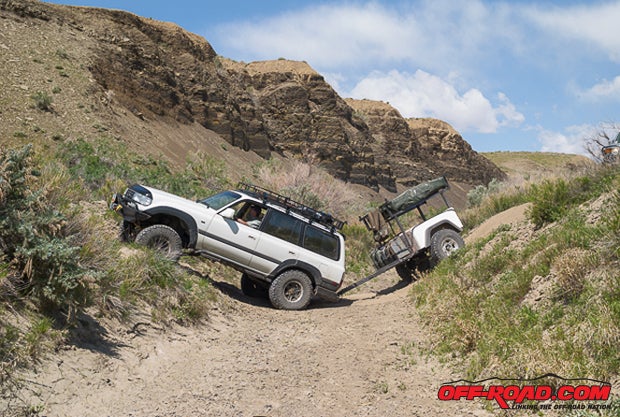
How else is Dinoot different? Scott has effectively blurred the lines between his business and the online learning community of fellow DIY enthusiasts. He has created both company websites and sponsors a forum (Tventuring.com) that focus on the creativity and shared ideas of others, as well as descriptions of “how to’s” yield no profit option for him. That philosophy for evolving designs, learning as a community, and identifying new products is a testament to both his outlook as a businessman and the rapid response his simple-yet-thoughtful trailer systems allow. Scott celebrates the creativity of others, featuring oodles of others’ trailers and campers on his web site, and doesn’t reinvent the wheel. In fact, there may be only a handful of persons who have collected and studied as many trailer/camper designs as Scott.
I am no newbie when it comes to owning or building custom trailers. After owning a quiver of trailers, from commercially-made units to military and customized specialty designs (e.g., a dual level raft trailer based on a VW bug suspension), I was ready to dial in our family needs via the fiberglass-panel based Dinoot. Scott helped me to choose from among the several Dinoot options, the most important of which was the bed size. Already owning an M101 and a snowmobile trailer, this design was going to be solely for camping, overlanding, and occasional light-duty cargo hauling. The choice between the Compact (53” L x 59” W x 20” H) and Extended (6’-6” L x 59” W x 20” H) bed or “tub” designs was thus a no-brainer. I didn’t want the length of the Extended model nor its near replication of the M101’s cargo capacity. Weight was not a deciding factor, as the four fiberglass panels of the Compact weigh about 40 pounds, and the Extended version adds only a few pounds more.
With the tub kit selected, the next choice fell to what tire size to go with. More specifically, what tire size would I ultimately end up with on my 1997 FZJ80? The decision matters because trailer bed height is best matched to one’s vehicle body height. From a performance standpoint, running trailer tires that match those of the tow rig enables flexible swapping in emergencies, as well as the possibility of only carrying a single spare to serve both truck and trailer. With that in mind, I pulled the trigger on a set of used 315/75/16 BFG MT KOs already mounted on matching Land Cruiser alloys.
There are certainly lighter and lower rolling resistance tire options than the classic 35x12.50. In fact, my desire was for the narrowest tall tire possible. I even picked up a pair of 255/85/16s with full intent to use them. That size offers the best balance of narrow and tall that’s widely available in a trail tire. In the end, however, my desire for matching tire sizes trumped the lower weight and somewhat reduced drag coefficient of the 33s. Also, it was clear that the larger tire’s additional width would help with stability, and that running higher psi would still mean minimal highway resistance in the end.
The next design decision in building a Dinoot, which is actually made in concert with tires and wheels, is the axle. There are options out there to fit about any desire, including fab’ing independent suspension arms. But there’s no point in debating the wisdom of a perfect axle, any more than discussing perfect 4x4s; neither leads to “the answer.” If well built, most trucks will work fine when used within their design limitations. The same is true of axles. Too lightweight or too overbuilt for the purpose will lead to a failure of the system and/or an empty wallet. To get a matching Toyota 6x5.5 bolt pattern on our axle’s hub most companies will require a 3500-pound axle. While that’s clearly more than is needed for a trailer aimed at 1000-pound gross weight, the benefits become apparent in lower cost, width customization, and brake options.
Are there more sophisticated solutions than a straight axle? Sure. But I no more wanted a complicated system than I’d want a G-wagen from Mercedes as my trail rig and daily driver. Sure they’re cool. But you’re going to pay at some point for that coolness. Serviceability, simplicity and toughness win out with a straight trailer axle, especially since less than $200 buys an entire axle of this rating made up in the exact width of your choice.
The Dinoot philosophy on the backbone of a trailer—the frame—is also KISS or custom. That is, you can keep it simple by using a Harbor Freight off-the-shelf trailer frame (and matching axle, if desired), or a similar sized unit [Note: fitment solutions will obviously be required if you do adapt one from another manufacturer]. To go a bit more custom (as well as sturdy), you can follow the well-documented design on the Dinoot website, and weld up your own. Or you can customize from there, making a foundation that’s as mild or wild as you like.
The frame I built was based heavily on the Dinoot design. The alterations I made resulted from several weeks of wrangling over my intended usage, as well as reading countless trailer design posts and articles. First and foremost, I had to decide the tongue length. In my case, that meant measuring my other trailers’ hitch-to-axle length. Each trailer, when towed and especially when backing up, handles somewhat differently. As an off-road trailer I wanted a responsive design without it being unforgiving. The sweet spot was going to be a length slightly longer than the stock M101, which in my experience is slightly too twitchy, and tends to go into unrecoverable jackknife beyond a very subtle point. That trailer’s measurement is 97”. As a result, my goal for the Dinoot was 105” hitch-to-axle.
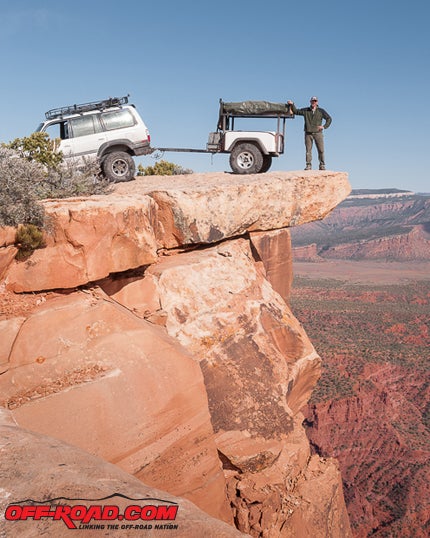
The other consideration for the trailer was cargo capacity on the tongue. I wanted the ability to haul five to six Jerry cans on a rack, as well as to load a small trail bike (e.g., Honda Trail 90) or bicycle hitch carrier. For those I needed length and the ability to mount a receiver. Similarly, my family does a good bit of whitewater, and I wanted to load our rolled 18-foot raft on the tongue. In the end, the extra tongue length was a near perfect match for the desired handling. The only necessary change was to set the axle slightly forward of center on the trailer tub. While that change causes a modest loss of departure angle, it wasn’t something I couldn’t solve with sliders. Thanks to the quality of the Dinoot fiberglass side panels, which average 1/8” or thicker, altering where the fender cuts were made didn’t present a problem either.
Once you have the tub, tires, axle and frame resolved the last significant decision is the hitch. If you’re not familiar with the arguments about ball couplers versus pintles versus other designs, suffice it to say that a ball will work for moderate trails. The challenge comes when angles between the trailer and tow vehicle become more severe. As a long-time user of military pintles, I love their simplicity, toughness and safety. Unfortunately, they’re also not quiet, nor are they without rattles and jolts. So what does that leave?
A few companies have stepped into this quandary by providing dedicated trail designs for couplers. After more research I chose the system to use was the Lock-n-Roll from Great Lakes Forge. Located in Chicago, the company introduced the original Lock-N-Roll as a result of their fifth-generation blacksmith heritage. Since then they’ve tested, revised and expanded the basic tri-rotational design, resulting in over 20 options of the core design. This allows the buyer, as with the Dinoot itself, to dial in the perfect unit. To figure out which was best for our trailer, I worked with the Great Lakes Forge owners. Based upon my needs they suggested their model 506 weld-on coupler, along with a PN 505 channel and matching 503 hitch. In combination they would allow a 360-degree rotating connection with a serviceable pivot. At the same time, the adjustable mount of the PN 505 would allow for modest height changes due to possible suspension or tires.
Lock-n-Roll
The Lock-n-Roll is not a dainty unit. When you feel the heft of the thing (the 503 and 505 weigh 25 pounds together) you’re not surprised that it came from a company with “forge” in its name. This most critical component in a trailer system undergoes constant loads, and it is subjected to stresses that would make an engineer giddy. Add the pounding of rated trails and you have a recipe for failure. To overcome those demands, a coupler must be more than heavy duty. It needs to be trail smart. That is, its design needs to account for the twists and turns of extreme articulation, and also overcome the challenge of creating a smooth, if not silent, action.
The Lock-n-Roll meets these demands via a simple-yet-sophisticated design. Its three separate rotation points isolate different actions, putting less load on each, and relies upon careful tolerances rather than elastic or polymer connection points. The heart of the system is the unique safety lock system. Twin catch plates drop onto the outboard pins on the tongue-mounted coupler. This system is not only massively built, it’s smart. Failing to insert the lock pin won’t undermine the coupling. Once under load, the catch plates remain in place until weight comes off the tongue, such as raising with a jack.
How does it perform? Attaching the couplers is quick and simple, with more margin for alignment error than a ball in a fore-aft direction. Laterally, thanks to the pivots, there is also some range of alignment freedom, though the fit tolerances mean the positioning must be in the ballpark for the outboard pins to drop into the twin slots. Once aligned, the catch plates can be easily rotated into place before a load is placed on the Lock-n-Roll.
On the highway, the Lock-n-Roll is as smooth and forgettable as a ball coupler. That’s not saying much, given that pavement driving places little stress on the whole. The real test for me was on Utah’s famous Kokopelli Trail. We drove the 100-plus-mile route as part of Cruise Moab 2013. The three-day run traverses a wide mix of trail conditions, from dry sand washes to creek crossings, slickrock ledges to boulder gardens. Throughout the trail the Lock-n-Roll performed flawlessly. Its articulation allowed 100-degree jackknife’s for about-face direction changes, and the beefy construction held up to hours of dragging the Dinoot over nasty terrain.
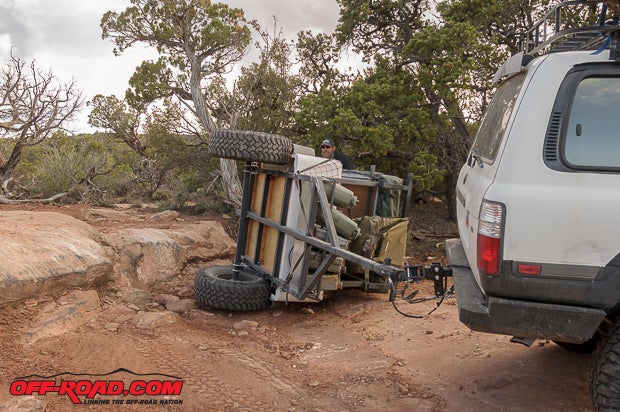
The most severe tests came on the infamous Rose Garden Hill and the loop trip up to Top of the World. It was on the latter that eight hours of hard trail driving took their toll. In a moment of inattention I managed to counter steer the wrong way off a 3’ ledge. The trailer gently touched the first tire down, but then continued to tip, flopping over onto its side. Instead of the trailer’s momentum translating into a limited-motion ball coupler, which likely would have failed, the Lock-n-Roll’s articulation kept the force isolated from the truck. As it was, five of us lifted the unscathed Dinoot upright and the drive continued.
Building the Dinoot
What does it take to build a Dinoot? To chronicle that process in much more detail, I’ll be describing the step-by-step project at the Tventuring forum. If you’re interested in building one yourself, that thread will give you a good idea about the time, tasks and costs of a build like ours. On the Tventuring forum there is also a growing number of other Dinoot build threads. For the purposes of this article, I’ll give a more basic overview. On a 4-banana scale of difficulty, I’d rate this project a 2.5 or 3. Keep in mind that my build involved: 1) designing and fabricating the frame, 2) sourcing a custom axle, and 3) building the floor and tub. I don’t include in that rating the additional feature of the custom rack and Eezi Awn tent mounting. I’d probably describe it as closer to a 3-banana job, given how I made the rack to raise and lower, if those were included. If you built the trailer starting with a Harbor Freight frame it would be considerably simpler, though obviously less durable or personalized.
The key points of the design I used are a welded 2-inch square-steel tube frame with an oversize central 3-inch “spine” that also serves as the tongue. Simple and strong, the basic frame, without springs, Lock-n-Roll or jack, weighs approximately 90 pounds. That is without nerf bars and storage systems either. It would be easy to have gone either heavier or lighter; however, I would refer you to a reputable steel strength chart before you decide on tube size and wall thickness. It’s easy to both go overboard for not having done some basic math, as well as to try and make it super light and in the process save only a few pounds while sacrificing too much strength. Above all, be honest about how much or how little payload you’re going to haul. Trailers don’t often fail since most guys overbuild them. But when they do fail it is frequently the tongue that is the weak link, and the results can be catastrophic, if not deadly.
Another of the beauties of the Compact Dinoot is floor fabrication. Having the ability to use a single sheet of 5’x5’ Baltic birch for the floor offers a simple solution. This tough, high-quality specialty lumber can be sourced through wood suppliers who serve cabinetmakers. I located a sheet through MacBeath Lumber in Salt Lake City, ordering it in 3/4-inch thickness. Because they didn’t carry marine-grade versions of the product, which is the ideal, I relied upon a spar urethane applied in several coats, along with a roll-on bed liner to protect the floor, wheel wells, and inside tub walls. Using similarly waterproofed wood risers, the tub had sufficient clearance even with the big BFGs. In fact, I’m convinced that with only minor changes to this design you could run 37” tires with the littler Dinoot.
The next phase of the build will involve creating a lid to enclose the bed, as well as adding nerfs, shocks and miscellaneous storage options. The Dinoot has lived up to its billing as a DIY trailer for the masses, with options galore to make the trailer fit your needs, style and budget. Whether entirely sourced through Compact Camping Concepts, using only their fiberglass tub kit or something in between, the Dinoot line affords a huge range of choices to meet your off-road trailer plans. With friendly, personalized customer service and a wealth of online materials for planning and carrying out a build, the company has made an important addition to 4x4 and overlanding communities.
Part II of this review will appear in early fall of 2013, and will chronicle the Dinoot’s performance and build evolution.
Conacts
Compact Camping Concepts
http://compactcampingconcepts.com/
Lock 'n' Roll
https://www.locknroll.com/


 Your Privacy Choices
Your Privacy Choices